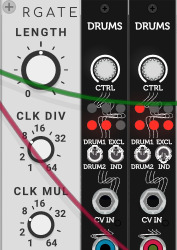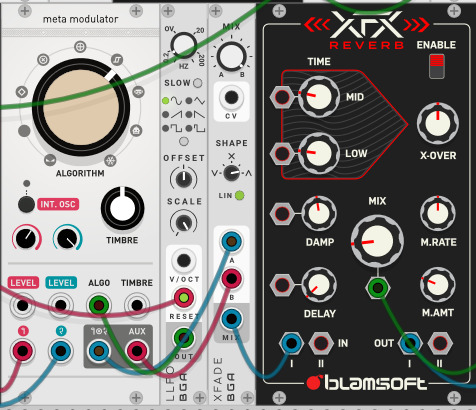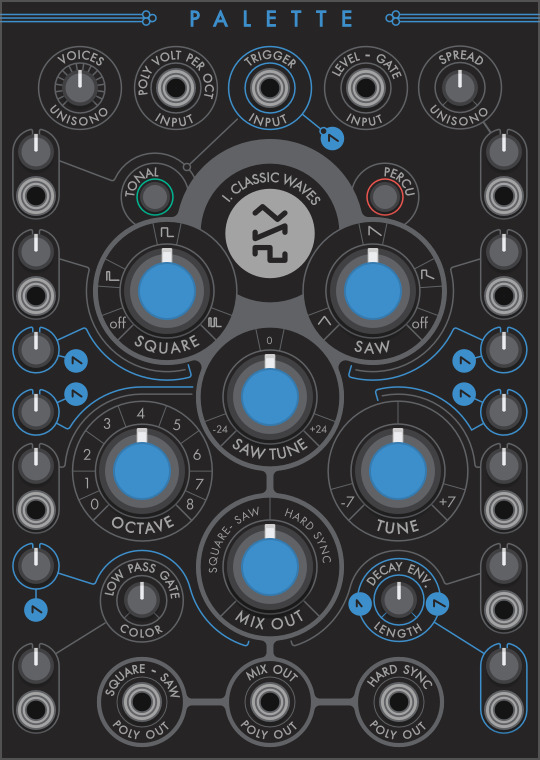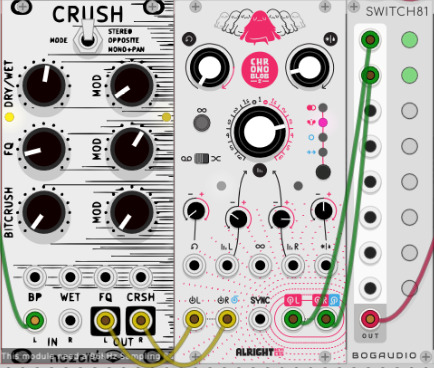Photo

Unit Reflection
This unit has been quite the rabbit hole for me. Deep diving into the realms of IDM, breakcore, musique concrete, electroacoustic music and the various types of synthesis inherent within them. Modular synthesis in particular has been very eye opening to the world of music creation outside of software and plugins.
Overall, I’m content with the work I have produced but it is far from perfect. I still have concerns about track length with some being too short and others too long and a general feeling that my contemporary tracks rely to heavily on my DAW.
I can’t shake the feeling that my west coast compositions sound and feel more creative due to the restrictive nature they were composed in. Whereas, my east coast compositions feel like they could’ve been expanded upon. I think I could’ve created and implemented more patches in VCV remedy that.
I believe that the theme and general concept of my EP was a success. Each track highlighting an extreme to drum synthesis and sequencing until the EP closes on the utter obliteration of rhythm itself.
0 notes
Text
Track 1 - Braids
Objective:
I wanted to establish my EP’s concept swiftly. I wanted the opening track to be able introduce these concepts of rhythm and it’s manipulation without giving away too much. The plan was to create a bed for the rest of the EP to build upon.
Design:
I decided upon the theme after a deep dive and recent obsession with breakcore, a very niche and experimental sub-genre of DnB which takes the classic breakbeat sample programming to it’s absolute extremes. As the EP had to consist of a minimum of two contemporary tracks and at least one west coast inspired composition, I knew I wanted to ramp up the chaos and extreme rhythms gradually but that didn’t mean my rhythms couldn’t be complex or interesting.
The Patch:
Learning the workflow of VCV Rack and modular synthesis was a slow but rewarding experience. As soon as I had VCV ready I knew that I wanted to play with the Mutable Instrument modules and I focus primarily on Plaits. After integrating my midi keyboard in VCV and playing around with some basic waves I had an idea for a melody line. However, due to the varying time signatures it was difficult to play for exteneded periods of time until I decided to implement a sequencer to play my melody.

After dialing in my sequence I began to play around with Plaits and it’s multible wavetables. I was considering using a more electronic sound until I found the more organic sounds in Plaits. I managed to adjust the harmonic, tone and morph pots of the module to create something resembling a string instrument. Paired with the phrygian melody line this created a very dark and eastern tonality which meshed well with the ideas I had for the EP.

I used Palette to create a bass in a similar manner to my lead tone as they are both wavetable oscillators. I used one the outputs of my master clock to add rhythmic content to the bass and a more rudimentary sequencer to pitch the bass as neccessary. I recorded both parts and began working in Ableton.
Composition:
I knew I wanted something to differentiate this track and try to subvert the listeners expectations. I relied on shifting time signatures to define the rhythmic manipulation which can be jarring if the listener isn’t used to an uneven beat. However, this is conceptually more well known and arguably more digestable than electroacoustic music or west coast synthesis.

The majority of the track sits in 15/8 but realistically moving from one measure of 7/8 and two measures of 4/4. This choice wasn’t arbitrary as I still wanted the listener to feel moments of comfort with the stretches of 4/4 and feel tension or unease from the decapitated beat.

I added little moments for the drums to glitch out. I wanted a teaser or a prelude to what the EP would consist of. After post processing and adding a significant amount of effects to the bass patch and Plaits melody I feel I was able to short yet effective introduction to my EP and learn a good deal about VCV and modular synthesis in the process.
0 notes
Text
Track 2 - Dhomont
Objective:
To create something avant garde was the goal. I wanted to create something that would essentially turn its nose up at traditional western harmony and rhythm while still retaining a sense of musicality to myself and displaying a thematic correlation to the other track in the EP.
Design:
The musique concrète of Stockhausen and the more modern interpretations of Francis Dhomont’s electroacoustic music were big influences in how I tried to sculpt this track. I set out to make something that used my EP’s theme of drum and rhythm manipulation and see how far the extremes really were.

The Patch:
After setting up a masterclock at a reasonable tempo, I set up a three track sequencer. I implemented two seperate instances of the Drums module by EricaSynths and dialled in a kick, snare and hi-hat. With my masterclock’s outputs and built in clock divisions I created a halftime pattern with a repeating run of 8th note triplets. This alongside some percussive aspects of the kick created an interesting off-beat drum patch.

To add some variation I patched both of the EricaSynth modules into Mutable Instruments Warps, this would add some much need colour and unpredictability to the pattern. This was consolidated by routing a sine wave LFO generator to the algorithm CV input of Warps to smoothly transition between a handful of different effects.

I finally implemented a reverb module with a similar sine wave LFO and a very short decay to create the illusion of the drum samples changing in length. I routed this to my mixer and bounced the drum pattern to a WAV file via my recording module.
Composition:
It was difficult trying to vocalise or exactly pinpoint what I wanted the finished composition to sound like. I experimented with reversing and beat repeating but it still sounded too much like the original sample. While I still ended up taking effects like those to their extremes in later tracks on the EP I eventually found something that I could manipulate to get the sound I was after

After experimenting with the various audio rendering methods inside Ableton’s clip view, I began to really latch onto Ableton’s Texture feature which as it turns out is a form of granular synthesizer. As a frame work I layout automations for the size of the grain and the flux. This started to break my pattern in really interesting and unmusical ways.

Pairing very extreme pitch modulation and granular synthesis was what helped find the sound I was looking for. Dissonant, stabbing textures that pierced the metallic coil whine of the quieter sections. Through this I was able to create and arrange what was previosuly a bare drum beat into something entirely divorced from rhythm.
Though I still believe that I’ve managed to capture a sense of musicality within this composition. Every aspect of my VCV Patch was an intentional exercise in modulation and destruction. The dynamic and tonal aspects of this track were inspired by “Cycle du son” by Francis Dhomont which I allude to with it’s title.
0 notes
Text
Track 3 - Chroma
Objective:
Chroma is the second contemporary track and third overall track on the EP. This track continues what “Braids” establishes thematically but takes the destruction and manipulation of rhythm to another extreme.

Design:
I set out to see how far I could take the glitching and micro-editing introduced in “Braids” while mainting a contemporary feeling track. Like the first track, Chroma sits well into Drum & Bass whille occasionally dipping into the realm of Breakcore. Despite the odd time signatures introduced in “Braids” I was content to leave this composition in 4/4. If I introduced an odd time signiture while pushing the micro-edits and rhythm manipulation I believe that would firmly push it outside the realm of “contemporary”.
The Patch:
I knew I wanted more of a modern bass sound so I elected to use “Palette” by Atelier in VCV Rack. This module is essentially a reskin of Mutable Instruments “Plaits” which I used for the track mentioned above. However, I found that this module’s interface and general design to be a lot easier to understand.

Having said that, this module still had it’s learning curve. What sped up the process of designing a bass sound I was happy with was the UI differences. Having everything clearly labeled and change depending on what mode I wished to use was a godsend. Utilising what is essentially the same module but with a more user friendly interface definitely sped up the process.
After patching in a quantizer to establish my root note I began to experiment with the module. I again decided to use the wavetable oscillator function as I felt it was previosuly succesful in creating the more modern bass tone I wanted.

Keeping the octave low for better bass frequencies, I patched an LFO into the CV input of the wavetable row. This created some movement and added some nice harmonic content too. Adjusting the column CV input to a desired range gave me a bass tone I was happy with. I patched it through a standard VCF and VCA module to design the attack and decay of the bass, creating a a short growl with nice harmonics as the row CV modulated.
After sequencing a square wave into a basic arpeggio with a sequencer I patched the bass and the arp through a simple reverb module. I felt that sharing the same reverb gave the arp and bass some more connection and was quick and easy to implement. I then recorded the bass and arp seperately and tranferred them to my DAW.
Composition:
As I began sequencing and arranging my rendered patches I found myself seeing this track as a sibling to “Braids”. By replicating the bass voice introducing the track through layers of reverb and delay I saw an opportunity to create a motif within the east coast tracks of the EP.
The rhythmic content of this music and manipulations of said content are a focal point for the EP. However, with this track I opted to give the kick drum time to breathe between the glitching of the rest of the kit. I felt this allowed the listener to find some rhythmic predictability amongst the chaos and find an anchor in the downbeat.

My goal was to contort the remaining parts of the kit into something that would feel at home on a Squarepusher or Venetian Snares record. Using a hanfdul of plugins I automated extreme panning, retriggers, shuffles, reverb, EQs, modulators, bitcrushers and other effects to replicate the chaos of these artists.
I decided to juxtapose the anarchy in the rhythm section to the droning, predictability of the Pad, Bass and Arp. I liked the sheer contrast of these against the undanceable rhythm. Even the bass, despite it being harmonically rich and often the most aggresive in these genres, is tame in comparison.
Both this track and “Braids” share the influences of DnB, Neurobass and Breakcore in their sound design and rhythms. I found that this created more of a throughline in my EP’s aesthetic and tone. Each track feels different but at home next to the others.
0 notes
Text
Track 4 - Transentience
Objective:
Transentience is the second West Coast inspired track and what brings the whole EP to a close. I wanted to extrapolate further on the EP’s theme of distorted rhythms in a rudimentary, but interesting way.

Design:
While my two contemporary tracks on the EP are built around the use of western 12-tone and “Dhomont” plays with pitch. I wanted to arrange something entirely devoid of pitch used with any musicality. While “Dhomont” explores the extremes of sample destruction through Granular Synthesis, I wanted to manipulate and distort this patch through its transients and it’s struggle to cope with an inrrational BPM.
The Patch:
I began loading in Drum Samples that I thought would generate some interesting transients for me to be able to play with. I relied on my HiHat generator module as I could very easily manipulate decay to extend transient length for variation. I sequenced a halftime rhythm with my kick arriving on the first beat and my snare on the third.

The hat generator was patched into a clock divider to turn the 8th note hats into a 12th note rhythm. I thought this would make for a more interesting rhythm over something more straight.
Finally, before routing my drum pattern to the mixer I patched it through two modules, the first being a bitcrusher and the latter being a delay. Various parametres of the bitcrusher were able to be modulated without a clock signal and create almost randomly generated crushes and distortions on different beats of my drum pattern.

I patched in a similar function to the delay module which added a very fast and tight delay effect. These two effects effects alone created a decent amount of variation and grit to an otherwise fairly standard beat.
Upon rendering the track it was time to start manipulating it in ableton.

Composition:
I was heavily inspired by Francis Dhomont with my first west coast track, being one of my favourite electroacoustic composers, which is where it's title comes from. I wanted to continue with my theme of drum manipulation in a less derivitive way, while "Dhomont" relied on materials and extreme pitches from my manipulations I wanted to experiment with transients.
Keeping an audio clip "warped" in Ableton will cause it to remain static regardless of increases or decreases in tempo. Warping my drum pattern at 500bpm and then reducing the tempo to a mere 50bpm was enough to nearly destroy it's original recording. I set Ableton to try and read the transients as a beat. This caused the sample to have a CD skip kind of effect. Trying to understand readable information from the audio at such a low tempo created the glitchy destruction you hear on the final track.

I implemented a technique I had used in "Dhomont" to create more variations and destruction which involved heavy automation of the transposition function. The drum sample's stutters would either increase or decrease depending on which direction I transposed it. Sprinkling in delay and reverb created some extra space and a brief refuge for the listeners ears.

Schizophrenicly automating the tempo of my DAW and sample created a strange feeling. There is still rhythm and movement to this arrangement but it was fun finding ways to destroy that in unexpected ways. One moment you can follow and nod along to what sounds like the original beat, and then the next it disintegrates and all function of traditional rhythm is lost.
It was challenging attempting to create something that ignored contemporary rhythm and harmony but still felt musical, whether I was successful is entirely subjective. Personally, I believe I've managed to create two pieces that reflect the west coast ethos.
1 note
·
View note